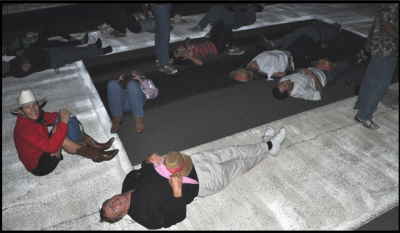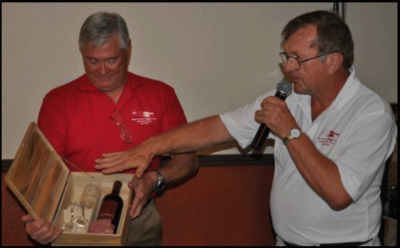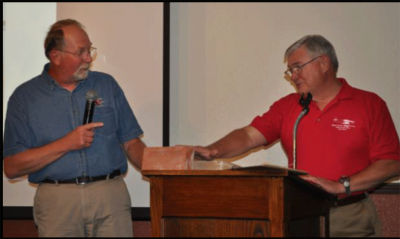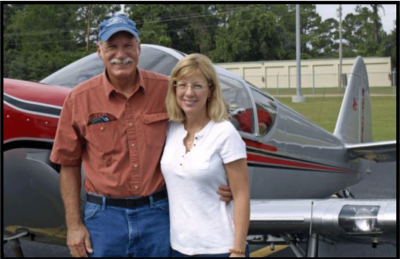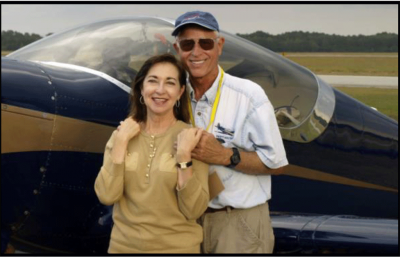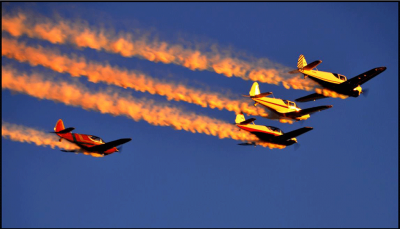Download this newsletter in pdf format.


Editor Comments
Well….here we go. This month we are starting the first issue of the Swift Newsletter by Electronic Transmission. To insure that we launch this venture well and not leave anybody out, we will send hard copy to all….but what we are aiming for is to get the Newsletter to as many people as possible via the internet. This will allow us to get more information, pictures, announcements, updates, articles etc. to you in a very timely fashion … plus it will save a few hundred dollars a month in postage. We will be sending the newsletter out as an email. However, you may still access it via the web site as well. Instructions for web site access are as follows.
To get the electronic copy via the web site just do this: I. Go to: swiftmuseumfoundation.org; 2. Go to “members only” section on the right screen and Log in. 3. Enter your user name and password. (if you are logging in for the first time and have not been approved …. you will be sent to a page that says.. “invalid username and password”. 4. You will then need to click on the link to “Register”. (At that point you will be able to put in a user name and an email address and you will be sent a password to access the website as a subscriber. When you are verified … you will be added to the Membership section.) S. After that, whenever you sign in you will have access to all the things marked… “Members Only”. You will also be able to update your Member Profile and change your password to whatever you want.
If you have any problems with the site or your sign in just call Pam at HQ and/or Tracy Rhodes tracy@sierrawebsolutions.com and we will help get you going. OK, let’s give it a try.
—————————————————————————————————————————————-
Executive Director Comments
The Thanksgiving and Christmas Holidays are quickly approaching. As you plan your wish/gift lists please keep your Swift Parts Department in mind. We have many great gift ideas in stock for you, your Swift and for you and your Swift family and friends. Here are just a few of these items:
Laser cut P-5 I style wheel covers
# 16085 Adel Struts
#16085 Adel Strut Bushings
# 1228-1 Leading Edge Wing Root Fairings
#2591 Flat Instrument Panels
Cyclo Polishers, Pads and Polishing Cloth
Nuvite Nu-Shine 11 Polish, Nu-Image Cleaner/Debugger, etc.
New Style Aluminum Finish Swift Wall Clock
T-Shirts, Polos, Hats, Jackets, etc. (Call for colors & sizes)
Nice Embossed Swift Jotter & Pen
We are progressing nicely with the sewer installation and expect it to be operational by the time you receive this newsletter. We have also received confirmation from our local Comcast office that, at long last, we have been approved for new service. This service has previously been unavailable for our location. This new service will offer better service with significant monthly savings.
As we mentioned last month, we are so very grateful to those of you who think of your Swift Parts Dept. when you have Swift items to donate. And, as always, remember SMF, Inc. when you are doing your estate planning. Your gifts are what keep us going in our effort to sustain our goal of supplying parts, information, fellowship, and the wonderful history of the Swift.
—————————————————————————————————————————————-
 Board Chairman’s Report by Bill Kientz
Board Chairman’s Report by Bill Kientz
As we approach the end of 2013 it is apparent that it has been a remarkable year for all of us in the Swift world. We should all take great pride in the progress we have made this year and as we approach Thanksgiving perhaps it is time to reflect a bit on all the exciting events that Swifters have encountered through the year. I personally take enormous pleasure in attending as many fly ins and events as I can and just love to see all the marvelous Swifts that we have in our fleet. I firmly believe we have a fleet of aircraft unmatched in quality and beauty… end to end … of any in the country. We all have experienced people, line jockeys, aircraft fans across the country that are just naturally attracted to the smooth lines of a Swift and marvel at its age and condition. People just like to look at Swifts it seems. My favorite story is about the 10 year old looking at Swifts who is overheard telling his Father…”Dad, why don’t we stop looking at other airplanes and just go buy a Swift….it is really cool and obviously the best out here.”
We have all witnessed the progress at Swift HQ and your new building for HQ and Parts is rapidly approaching completion. It, in turn, will soon be hosting and storing all our parts in a truly organized manner … which will make it easier to locate and ship parts to you. Accordingly, it will also make Pam’s job much easier and will contribute to a smoother running HQ fully responsive to you. We have spent over $65K on parts this year in order to keep your Swift in tiptop condition and we hope to continue this approach to fully support you.
Swifts did well all through the year with awards coming at Sun n Fun, Oshkosh and the many well organized fly ins that we seem to excel at. Many thanks to all those who “make it happen” for these outings. How can you beat having fun with your friends in nice locales with the common denominator …. our Swifts.
Achievements are many in Swift world and we have tried to note them throughout the year. Romain’s trip from Florida, through Oshkosh and on across the Atlantic to France certainly stands out. John Johnson’s rookie race at Reno (see article in this issue) was extraordinary plus the many fun events we participated in from coast to coast.
We do have challenges ahead, such as building our Endowment fund with a strong reserve which insures we will keep the “doors open” and provide you with parts and support. We also are working hard to obtain the funds to finish the Museum part of our facility. Next June 4-8, we will all convene at Dayton for our Swift National. This has been a long time in planning but now we will show the Swift colors at the cradle of aviation in America. Please don’t miss this event… it will be memorable.
Just a word on some of our long time Swifters. We have received word that David Fox has been placed in a full time care facility. As you might recall, David and Becky most generously donated N3271K to help raise funds for Swift. Cards and letters would be most appreciated. His address is: David Fox, Huron Woods, Riverside #2124, 5361 McAuley Dr, Ypsilanti, MI 48197. Also, we were happy to see that Dick Collins was able to make it to Westover this year. However, Jeanne although doing better was not able to come. Notes or cards to her at: 450 Minoca Road, Portola, CA 94028-7755 would be most appreciated. I cannot conclude without thanking all the volunteers who make the Swift world go. We are, after all, a small non-profit, all volunteer organization but we always seem to find a way to get bigger and better every year.
My hat is off to all of you. Happy Thanksgiving.
—————————————————————————————————————————————-
CloudAhoy by Steve Roth
For those having iPhones, there is a cool (and free) app called “CloudAhoy. This app records your flight from beginning to end … and you can replay it using Google Earth as a back drop. Thus, the imagery is “real” but not current. Check out CloudAhoy on their website at http:// www.cloudahoy.com.
To use CloudAhoy you have to sign up on a PC and create a free account. Then, start your iPhone app prior to departure. It uses your internal GPS to know your location, so you iPhone must be in a place to receive reliable GPS. There is a setting to have it automatically stop after you land. Then, when you check your account on your PC, you will see the flight and be able to “debrief it”. A neat feature is that you can send your “flight” to a friend to share it.
CloudAhoy is very powerful with lots of features, so it takes some time to explore all of its procedures. Also, I have found it does not work with “slow” airplanes (like our T-Craft). I have talked to the designer and he knows this issue and hopes to fix it. But, CloudAhoy works great with the Swift. Try it out.
—————————————————————————————————————————————-
HEADS UP: Emergency Gear Lowering System by Bo Mabry
After an electrical failure of the hydraulic pump motor, I was called by the owner of N22GW to help evaluate the failure of the electrical motor. Simply put, it was a short in the wiring system and very easy to repair. Since we had a failure to the system, we decided to do an emergency gear check and an emergency gear extension….standard procedure. To our surprise, we were unable to move the emergency gear crank handle. It was completely bound and totally inoperative. A gear up landing would have been inevitable if the owner had the need to use the emergency extension.
The system was removed from the airplane and completely disassembled. The culprit of the binding was caused by a bronze bushing….P/N 11 -532-2888. This bushing is located inside the jack screw P/ N 11 -532-2886. The bushing had completely failed and was broken about 3/8 inch and there was considerable dirt, sand and debris that we found in the system. It was easy to replace the bushing and reassemble the system and it now works fine.
We came to the conclusion that this is a 60 year old part … so we decided to inspect other Swifts. To date I have inspected 5 of these bushings and found that two completely failed and two more had cracks in them. The fifth was serviceable. The recommendation is that at least by your next annual you should remove the jack screw, clean each part and inspect the bushing carefully AND replace it if needed.
Based on our findings over the first 5 that we inspected it is evident that this bushing has a high probability of failure due to its age and the inherent grit that has accumulated over the years. Since this bushing is not in use during normal gear operations you most likely won’t know you have a problem until it happens. Granted, we do an emergency extension every year at annual time, however, it appears that it is now time to do a little extra work and remove the jack screw for inspection. I view this as essential preventative maintenance to keep your Swift off its belly. (Many thanks to member Steve Roth, who upon learning of this issue generously funded the immediate order for more bushings.)
—————————————————————————————————————————————-
Caricature Art of Your Swift
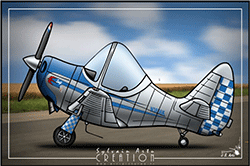 Another one of our fine members from France, Chris Chicouene has shared with us a great and fun idea for your Swift memorabilia collection. Chris is the owner of Swift N3856K formerly owned by Ed Lloyd.
Another one of our fine members from France, Chris Chicouene has shared with us a great and fun idea for your Swift memorabilia collection. Chris is the owner of Swift N3856K formerly owned by Ed Lloyd.
If you are interested in caricature art of your Swift you may email two profile view photos to sylvain.aerophotos@gmail.com Web address is: http://www.air-pictures.fr/crbst_19.html Many thanks to Chris for sharing this with us!
—————————————————————————————————————————————-
Westover by Carol and Gerry Hampton
This was a really fun fly in and despite the poor weather on Saturday we had a great time. All in all we had 27 Swifts, 2 Meyers, I C-182, 1 CJ-6, and I C-310 over the four day event….our 27th at Westover. We had great attendance at the Thursday evening gatherings at Mel’s, the Friday hangar BBQ and the banquet at Thomi’s on Saturday. We owe a great deal of thanks to those folks making donations for the door prizes and the auction. And, as usual the support from our friends at Westover Field was just super. Additionally we were blessed in having long time Swifters Dick Collins (picked up by Jerry Mahoney) and Bill Whelchel brought by Bill Gass. It is always a distinct pleasure to see these long time Swifters.
Friday night after the BBQ in the hangar… we once again held the post hangar runway walk which is always a hoot. Bill Gass managed to lose his keys while lying down on Runway 19 but they were found a little later. That’s right folks, lying down on runway 19. See accompanying picture of this tradition. Yes, that is Board members Ernie Hansen and Gerry Hampton prone on the runway….holding a brick from the old Globe factory. Go figure.
We had a formation clinic conducted by Sandy and Paul Marcandetti and got 4 pilots their ground school and test completed and had one training flight on Friday PM. Attached are some great shots of the formation with Don Bartholomew as lead, #2 Tracy Rhodes/Paul Marcandetti, #3 Nate Andrews and #4 Pete Donath/Sandy Marcandetti.
Twenty folks in 4 cars made the rounds on the wine tasting at three local wineries. It is alleged that more than a few cases of wine made their way back to Westover.
Saturday night concluded the fly in with the Banquet at Thomi’s. Stan Price did a great job as auctioneer for the evening and kept everyone entertained and engaged. Of course we had several Awards: Tired Butt Award: Steve and Barb Wilson from TX (in their Swift); Viewers Choice Best Custom: Miguel Nelson, N34RX, Frontier Airpark, WA; Viewers Choice Best Original: Jared Smith N3378K, Huntington Beach, CA; and Bud Knox Grand Champion: Kyle Hook, N90383, Petaluma, CA. Great job by all.
All in all this was a really great fly in and we sincerely hope you will all come back next year for our 28th Edition of the Westover Fly In.
—————————————————————————————————————————————-
Reno Rookie Experience by John Johnson
This article provides some real insight as to what is involved in racing at Reno. Stressful, demanding, excellent maintenance required, training for both the pilot and ground crew et al. Enjoy this fascinating venture. Due to its length it will be in two parts and will conclude in the December Newsletter. SJW
Background: It all started while sitting by the outside fire ring with a glass of Maker’s Mark at my cousin Craig Sherman’s house in April 2013. We were down in San Diego attending the Flying Tigers Pilot Association annual convention there. Craig has been an active racer at Reno and raced a GlassAir in the sports class for years there. During our conversation the subject of attending the 50′ Anniversary Reno Air Races came up. It was also the 75′ Anniversary of the North American T-6/SNJ/ Harvard Aircraft. It seemed to me this was something I didn’t want to miss and it also seemed like a good idea to get signed up and go to the races in September.
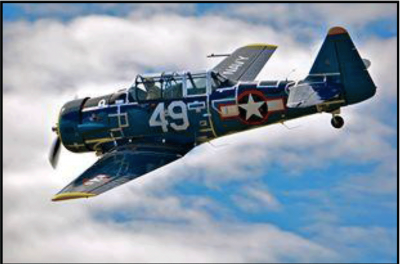 The first step was to sign up for the Pylon Racing School (PRS) because I had not been to Reno actively racing since 2000. Since the deadline to get into the PRS was only a week away I had to quickly download all the necessary paperwork, fill it out and (of course) send it by FedEx to the Reno Air Race Association (RARA). The PRS was to be held in June at Reno Stead Airport and turned out to be a very long 4 day exercise of intense formation flying and individual and group sessions on the actual race course. The flight down from Diamond Point was 5.3 hours and uneventful. There were just two rookies attending in the T-6 Class and four other veteran racers were there to help us along in our training.
The first step was to sign up for the Pylon Racing School (PRS) because I had not been to Reno actively racing since 2000. Since the deadline to get into the PRS was only a week away I had to quickly download all the necessary paperwork, fill it out and (of course) send it by FedEx to the Reno Air Race Association (RARA). The PRS was to be held in June at Reno Stead Airport and turned out to be a very long 4 day exercise of intense formation flying and individual and group sessions on the actual race course. The flight down from Diamond Point was 5.3 hours and uneventful. There were just two rookies attending in the T-6 Class and four other veteran racers were there to help us along in our training.
Reno … DAY 1: Pylon Racing School Begins at 0700 HRS, June, 2013. We had to go out and do some aerobatic maneuvers to demonstrate our proficiency in keeping the airplane under positive control while inverted and simulate being rolled over on our back and then recovering. In each of our flights there would be an instructor/evaluator with us until they felt we were ready to fly the course by ourselves. We then spent the next 3 days flying 2 to 3 sorties a day practicing flying at 50 feet at 200 mph and making runs around the race course. This is how it went.
Days 2-4: We started in groups of 2, then 3, then 4 on the course at the same time to simulate passing and dealing with traffic around the pylons. On day 3 in the afternoon session….we finally got to do a practice start. We would line up on runway 08/26 as if doing a formation takeoff but … we departed single ship in trail with 1 second tailwheel up spacing. Once we were all airborne the pace airplane would head North and we would rejoin in loose trail and climb to 8000 ft MSL. Then when we were about 3 miles to the North the pace plane would turn West and call us into close trail. We were told to check our engine instruments and to set up for power and mixture… subsequently we were sent into right echelon. As we approached the West boundary of the race course the pace plane would turn South and call us into line abreast formation. This is a very challenging formation to fly… especially in turbulent weather over the hills plus we were mixed in with gold, silver and bronze class T-6s. As we approached the show centerline the pace plane made one more turn to the East and started a shallow descent onto the course in front of the grandstands and past the Home pylon. Pace then called for all the racers to set final mixture and RPM. At this point the real challenge began as each plane accelerates at a different rate. The pace plane’s job is to get every racer in line and on speed by the start window. When the pace plane turns on his smoke you know things are looking OK …and then he calls “Gentlemen… you are released”.
At this moment… in every airplane … we all go full throttle and continue the descent onto the race course in front of the grandstands and past the Home pylon. If every airplane is the same speed then as you approach Pylon #1 the outside airplanes have to fly their high line so they can maintain visual with the aircraft next to them and they must be able to see the pilot’s head to their immediate left. (This means stacking high like in a finger four formation.) The new rules adopted by RARA state… you cannot pass any other aircraft until passing Pylon #3 Westbound on the back stretch. This rule was put into place to avoid all the airplanes trying to be in the same spot at the same time … which would definitely cause some paint swapping or bent metal… both of which would be hazardous to your health when flying at 50 feet and 200 MPH. After Pylon #3 … pilots were able to pass slower airplanes as necessary. A proper radio call has to be made by the passing aircraft to the passed aircraft. “Race #69 …Race #49 is passing on the right”. Answered by “Roger Race #49”. When the passing aircraft has safe distance ahead, he can ask if he is “clear”. The passed aircraft then states “Race #49 … you have the lead.” Passing usually happens on the straightaways but can also occur in the turns… especially if the overtaking aircraft is significantly faster. We go around the course for 5 laps … past Home pylon and then we pitch up 10 degrees to 6500MSL and set up for landing. Race control then clears you to land on the appropriate runway.
The landing involves a high approach at 100 mph, with full flaps to a mid point runway touchdown …in order to facilitate all the recovering aircraft. You then expedite exiting the runway, taxi back and shut down. After all that has happened just a short time before … you are soaking wet, your heart rate is up and the adrenalin is very high. Your crew chief then takes over maintenance and refueling duties as you head to debrief.
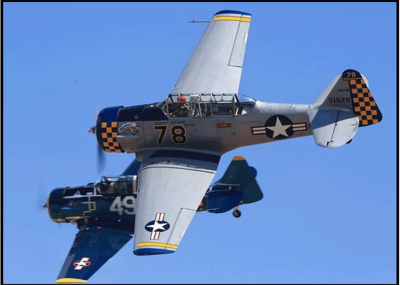 If all went well the debriefing lasts only a few minutes, however, when in training the instructors and veteran racers have a lot of comments that are both constructive and instructive. As this four day training period came to an end we had become proficient in the varied formations, race rules and techniques, and flying at 50′ and 200 mph. We had completed 4 race starts and we gained confidence in ourselves and our ground crew and aircraft. Racing at Reno is very exciting and intense to say the least.
If all went well the debriefing lasts only a few minutes, however, when in training the instructors and veteran racers have a lot of comments that are both constructive and instructive. As this four day training period came to an end we had become proficient in the varied formations, race rules and techniques, and flying at 50′ and 200 mph. We had completed 4 race starts and we gained confidence in ourselves and our ground crew and aircraft. Racing at Reno is very exciting and intense to say the least.
The trip home was another 5.3 hours and upon arrival part of my ground crew and I started to do some of the modifications to hopefully make #49 go faster. The only inexpensive fixes you can do are to reduce drag, seal off air leaks, or try to make the engine run more efficiently. We removed the exhaust collector ring and had it powder coated and wrapped the induction tubing to keep the intake air as cool as possible. We also installed a single piece front cockpit windscreen, removed the tail hook and .30 cal gun barrel and fabricated/installed a wheel seal kit using a strip of rubber. Additionally, we modified the top accessory cowl to remove gun blast deflector, installed new rubber seals on the left and right wing bands, sealed up any obvious holes in the airframe, changed the tail wheel tire to a smaller diameter etc. All this… to squeeze as much speed out of a 1942 North American T-6 trainer airframe and its stock Pratt and Whitney 1340 AN 1 600 hp 9 cylinder radial engine.
In next month’s newsletter… WE GO RACING with John and #49.. Stay tuned.
—————————————————————————————————————————————-
Georgetown, South Carolina by Sylvia Brown
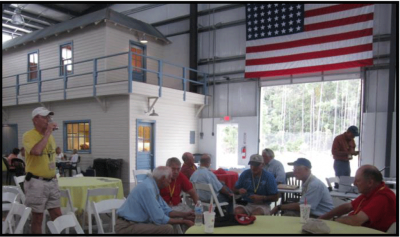 This was a unique event in that we had both Swifts (From the SSAG) and Navions (From the SNAG) attend. Sylvia and Bud Brown and Robert and Roye Ann Dickson were our super hosts and we used Robert’s new WW II hanger as our command post. (This hangar is very nostalgic in that it includes a replica WW II barracks style office and lounge, a camouflaged floor, a 48 Star American flag and of course Robert’s P-51D Mustang… “Swamp Fox”… plus the Buckaroo. Real cool.) We were hindered a bit by weather but most made it in on Friday and we had 22 aircraft: 8 Swifts, I Buckaroo, 12 Navions and the P-51. We would be remiss if we didn’t mention the outstanding support from the local FBO. They provided their conference room for the evening gathering and generously gave us a large discount on AVGAS.
This was a unique event in that we had both Swifts (From the SSAG) and Navions (From the SNAG) attend. Sylvia and Bud Brown and Robert and Roye Ann Dickson were our super hosts and we used Robert’s new WW II hanger as our command post. (This hangar is very nostalgic in that it includes a replica WW II barracks style office and lounge, a camouflaged floor, a 48 Star American flag and of course Robert’s P-51D Mustang… “Swamp Fox”… plus the Buckaroo. Real cool.) We were hindered a bit by weather but most made it in on Friday and we had 22 aircraft: 8 Swifts, I Buckaroo, 12 Navions and the P-51. We would be remiss if we didn’t mention the outstanding support from the local FBO. They provided their conference room for the evening gathering and generously gave us a large discount on AVGAS.
Friday evening we had a potluck dinner with all the trimmings and a whole lot of hangar flying and getting acquainted with our Navion friends. A really fun evening. The mystery of the evening occurred when we waked back at night from the FBO to the hangar. We heard an aircraft flying and then the squeak squeak of tires on the runway. There was no aircraft to be seen at first but as the sound of the idling engine got a bit closer we saw the completely blacked out C-310 turn off the runway come toward us and then stop about 100 ft away. Two gents got out and took off for the parking lot. What the heck? Never did find out what that was all about.
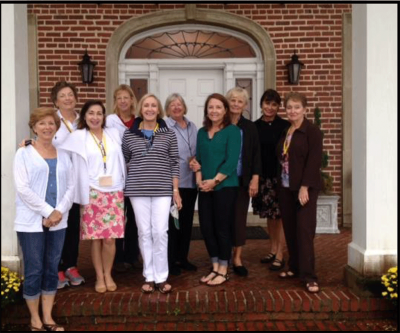 Saturday, ten ladies headed out in the morning for a private tour the Hobcaw Barony. Hobcaw is a 17,500 acre research reserve whose name means “between the waters”. In 1718, the land became a colonial land grant (barony) and was part of the great rice empire until the turn of the 20′ century. Hobcaw House was built in 1930 and Bellefield House was built in 1936 by Belle W. Baruch. Belle earned her pilot’s license in 1939 and put in a grass strip on her property. Her planes were turned over to the military and were used during WW II. Our guide was especially impressed that three in our group (Cindy Eckleberry, Lynn Roth and Linda Barker were active flyers.) This is an impressive estate that you should include in any future visits to the Georgetown area.
Saturday, ten ladies headed out in the morning for a private tour the Hobcaw Barony. Hobcaw is a 17,500 acre research reserve whose name means “between the waters”. In 1718, the land became a colonial land grant (barony) and was part of the great rice empire until the turn of the 20′ century. Hobcaw House was built in 1930 and Bellefield House was built in 1936 by Belle W. Baruch. Belle earned her pilot’s license in 1939 and put in a grass strip on her property. Her planes were turned over to the military and were used during WW II. Our guide was especially impressed that three in our group (Cindy Eckleberry, Lynn Roth and Linda Barker were active flyers.) This is an impressive estate that you should include in any future visits to the Georgetown area.
In the meantime, pilots do what they always do….either talk flying or fly. So we had some contests to liven up the Saturday afternoon: Bombing contest; Balloon Busting; and Spot landing. Swifts didn’t participate in the bombing as it is not a particularly good idea to open the canopy on most Swifts but we did well in the other two contests. The Navions dropped some really good “bombs” and had CEPS of 6, 12 and 13 ft. Excellent. Dick McSpadden, Rusty Harrington and Cliff McSpadden were the expert bombers. Balloon busting was next and to many the surprise winner was the Buckaroo piloted by Robert Dixon Jr.. Robert couldn’t miss…he broke all three of his balloons and then just for fun hit the next three also and broke another. Needless to say we were all impressed. In the Spot landing Rusty Harrington in his Navion won with Swifters Robert Jr. and Dave Carpenter right on his heels in their Buckaroo and Swift. This was a lot of fun, conducted safely and enjoyed by both our crowd and a good number of locals. We capped off the afternoon with a three ship flyby led by Charlie Sidenstricker, Tripp Smith was #2 and Robert Dickson Jr. #3 in the Buckaroo. Their formation was just outstanding and a fine ending to a fun afternoon.
We concluded the fly in Saturday night with an excellent dinner at Land’s End Restaurant. Excellent service and delicious food. Sunday broke clear and cool and all headed out for their home bases. We cannot thank Robert and Roye Ann and Bud and Sylvia enough for all their hard work in setting this up and getting the two closely aligned groups together. A lot of fun and some good memories. We’ll do it again in the future… so come and join us.
